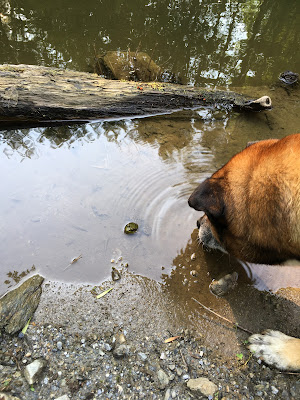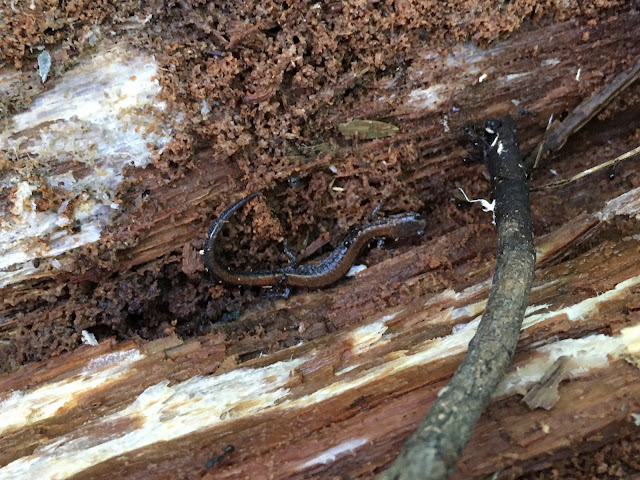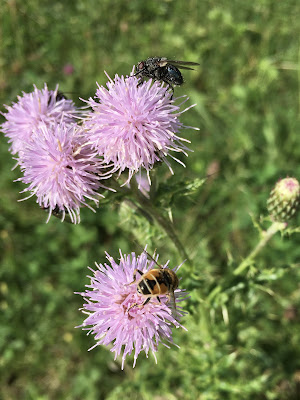220727 frog mumma
July 25
If I am being wholly present, then am I not "mind-less"?, meeting the moment with my heart or being? I suppose I would have to look at the meaning of "mind". There is a good deal of talk about "mindfulness" these days, and I think it is meant to be "being present", focussing the mind on the task at hand, be it work or play. One brings all of one's senses and thoughts to the "now", turning off the inner voice. This is a problem of language, isn't it? Sometimes I am mindless, just alive and here.
It is July, truly the month that lasts forever. I am taken up with mosaic work, cooking, walking, being, just being, on the porch with K or Rocky, taking time to be ("be") with Rocky. I am caught up in the life of the trees and birds and little insects - their being (again) blows me away (there is a word for this somewhere). I stop to look and am bewitched (!), yes, I think that is the feeling sometimes, joy and awe both, when I see, and must stop to watch, a creature or the woods.
Saturday was a day full of magic. I went to the friperie in town in the morning and discovered the perfect thing for the porch. I needed a second table of some sort, because my first is being used for mosaics, and I cannot put my tablet or phones there (grout and other dirt). Here was an old beat-up, painted-brown school desk: what could be more perfect; and it was not "vintage" priced, just a fair amount for a workable desk. Now the old ironing board that I was using can go to the mud room where I need something to hammer and dremel on. It was nice, but narrow, and it can be raised up to a good height for standing to do cutting and breaking.
My ironing board, also a frip purchase, now gone to the mud room:
My mosaic "table" and the new desk:
In the afternoon I went for a swim in Rain and Tal's pond. We have been in a hot spell, days of sun followed by a thunderstorm, more sun and then more storm, and Saturday was a sun day. I went alone to the pond and it took some wandering among ferns and brambles to find the place where the shore was cleared to get to the water. Such a small pond, with bull rushes and trees about, and I wore sock-shoes because of the questionable bottom, but nothing else. I have not swum naked in so many years that the experience became a ritual of magic and rebirth! A few feet from the edge I could not touch the bottom, and so I was a water creature. It was heaven. We say that often, but I truly felt transported to heaven and I felt that those moments were as long as forever.
Soon after I returned home, the storm came. We could see it approaching across the hills and the shags of rain. There was lightning, and the thunder was far away and then close and suddenly it rained and then hailed and the wind blew.
Rocky does not much like rain.
After supper, the sky cleared, the moon was near new so it was very dark. K and I sat and watched the stars, seldom so bright, across the whole sky. I could not name a single one in this July sky, but it mattered not at all. We watched for a long time while the Milky Way swung slowly westward.
*****
Frogs:
Other life: This salamander was in a log that fell open when I tried to lift it. He is three inches long, and shy, playing the stay-still card, while he can then finding a getaway while I stay still. I have found three of these now, looking under logs and leaves.
Some bees and beetles sharing resources:
Ray Bradbury once wrote a story, published in 1952, about a time traveller who goes back to the time of the dinosaurs and steps on a butterfly. After he returns to the present, he finds that history has been altered. I have thought, ever since reading that story fifty years ago, that this was "the butterfly effect"! But no, the term itself refers to a 1960's scientist whose computer weather models demonstrated that, from a puff of wind soft as a butterfly's wing flap, could come sunny skies or storm, and was much more to do with chaos theory than the danger of time travel. But I continue to draw wisdom from the "butterfly effect" of Bradbury's A Sound of Thunder. Wherever we walk, build, or farm today, we are "stepping on butterflies", affecting the future in ways we cannot fathom.
Ghost pipes! They are intriguing. They seem to be a fungus because they do not have chlorophyll, but botanists put them in the blueberry family. They absorb food from a fungus that in turn takes its food from the roots of a tree whose leaves photosythesize sunlight into sugar.
*****
Never underestimate the joy a gift of flowers brings. Thank you, Rain! These are from their garden.
Thank you for visiting! Keep well.
Mumma Yaga
Ray Bradbury, A Sound of Thunder, 1952. Included in a book of short stories, The Golden Apples of the Sun, published 1953.
"The term "butterfly effect" was coined by meteorologist Edward Lorenz, who discovered in the 1960's that tiny, butterfly—scale changes to the starting point of his computer weather models resulted in anything from sunny skies to violent storms—with no way to predict in advance what the outcome might be." https://www.aps.org/publications/apsnews/200406/butterfly-effect.cfm
Ghost Pipe: http://botit.botany.wisc.edu/toms_fungi/oct2002.html



























Comments
Post a Comment